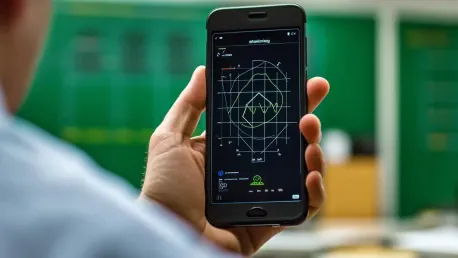Smartphones have evolved beyond their initial purpose of communication to become powerful, multipurpose devices. The integration of sensors like accelerometers, gyroscopes, and magnetometers has enabled smartphones to function as goniometers, which are traditionally specialized devices used to measure angles. This innovation has transformed scientific measurement tools, making them more accessible and versatile.
The Traditional Goniometer
A Specialized and Costly Instrument
Goniometers have historically served as essential tools in measuring angles within various scientific fields, but their utilization has come with significant limitations. These instruments, known for their precision, were stand-alone devices that required meticulous calibration and professional expertise to be used effectively. As a result, the average user was typically a specialist in fields such as chemistry, physics, or materials science, capable of interpreting and manipulating these sophisticated tools. This specialization inherently restricted their use to professionals who could justify the acquisition, training, and maintenance costs due to the instrument’s complexity and expense.
The traditional goniometer’s precision came at a high price, literally and figuratively, making it less accessible to a broader audience. Educational institutions and small laboratories often found the cost prohibitive, which limited their capacity to provide hands-on training and experimentation for students or conduct extensive research. This financial barrier meant these tools were not as widely integrated into curricula or research projects, impeding the broader dissemination of knowledge and limiting the scope of practical scientific education. The high price also stunted innovation in applications where lower costs could have fostered broader experimentation and adoption.
Limitations in Range and Usability
Despite their high precision, traditional goniometers were limited in both range and usability, which restricted their application to specific scientific domains. These instruments typically had a confined angular range, limiting the types of measurements and experiments that could be performed. Furthermore, the devices often required a stable and controlled environment to ensure their accuracy, thus restricting their use in dynamic or field settings. This lack of flexibility meant that certain scientific inquiries or measurements were constrained, hindering the ability to conduct comprehensive and versatile research or educational projects.
Additionally, the usability of traditional goniometers was another significant hurdle to wider adoption. These devices required substantial training and experience to operate effectively, as their calibration and precision necessitated a high level of skill and attention to detail. This complexity discouraged casual or novice users, making the goniometers less attractive for educational purposes where ease of use can significantly enhance learning. As a result, the high cost, combined with the necessity for specialized knowledge and controlled environments, confined traditional goniometers to a limited scope of use, preventing them from becoming more widespread and integrated into diverse scientific and educational applications.
Smartphones: The New Age Goniometers
Transformative Impact of Sensor Technology
The evolution of smartphones from mere communication devices to sophisticated multipurpose tools has been nothing short of remarkable. Initially designed to make calls and send messages, today’s smartphones possess advanced computing capabilities, rivaling traditional computers in some aspects. A significant part of this transformation is due to the integration of advanced sensors like accelerometers, gyroscopes, and magnetometers. These sensors, originally intended for improving user experience through features like screen orientation and motion detection, have now found applications beyond their initial scope, enabling smartphones to measure angles accurately and transform into efficient goniometers.
Through the use of built-in sensors, smartphones offer new avenues for precise scientific measurement, often with just the download of an app. This capability has revolutionized the perception of smartphones by highlighting their ability to function as scientific instruments. The practicality of having a portable, multipurpose device that can be used for both daily communication and complex scientific tasks helps bridge a significant gap. Institutions and individuals are beginning to recognize the untapped potential within their smartphones, thus broadening the scope of applications these devices can handle. With every improvement in smartphone technology, the precision and reliability of such measurements increase, making smartphone-based goniometers a viable alternative to their traditional counterparts.
Broadening Applications and Perception
The transformative potential of smartphones extends far beyond their role as everyday communication tools, as they are increasingly recognized as powerful instruments for scientific exploration and measurement. This evolution has prompted a shift in perception, where smartphones are not only seen as devices for entertainment and social interaction but also as credible tools for conducting scientific experiments and measurements. This expanded view has allowed users to explore diverse and creative applications, from academic research and professional work to simple home-based science projects.
Institutions and individual users alike have started leveraging this multifaceted tool in ways previously unimagined. In educational settings, for instance, smartphones can be powerful aids in promoting interactive and engaging learning. Students can now conduct experiments that were once too expensive or complex for a typical classroom. Similarly, professionals in various fields can employ their smartphones for rapid on-site measurements, making them valuable in areas such as engineering, architecture, and healthcare. This broadened application underscores the importance of recognizing and utilizing the inherent capabilities of smartphones, which can now serve as integral tools in both professional and personal scientific inquiries.
Accelerated Innovation and Development
Rapid Prototyping and Iterative Improvement
The innovation facilitated by smartphones goes beyond their immediate utility. By providing a platform where applications can be developed, deployed, and iteratively improved, smartphones have significantly accelerated the pace of innovation within scientific tool design. Developers can swiftly prototype new ideas, test them in real-world scenarios, and refine these tools based on user feedback, all without the significant overhead traditionally associated with hardware development. This rapid prototyping capability is transformative, enabling quicker responses to specific scientific challenges and fostering a more dynamic development ecosystem.
The benefits of this rapid development cycle extend to both seasoned professionals and enthusiastic amateurs. Scientists and engineers can continuously refine their measurement tools to better suit their specific needs, while hobbyists and students can contribute to and benefit from community-driven enhancements. By lowering the barrier to entry and reducing development time, smartphones empower a wider range of people to engage in scientific exploration and innovation. This democratization of tool development can lead to unexpected discoveries and applications, further advancing various scientific fields. The iterative improvement process not only ensures that tools remain cutting-edge but also promotes a culture of continuous learning and adaptation among users.
Democratization of Access
Transforming smartphones into goniometric devices has had a democratizing effect, making sophisticated measurement tools accessible to a broader audience. This accessibility is transformative for various user groups, including aspiring geologists, physical therapists, students, and hobbyists, who can now measure angles and experiment with scientific concepts using their portable devices. The ability to carry out precise measurements in the field without the need for heavy, expensive equipment expands the horizon of what is possible in terms of practical, hands-on learning and scientific inquiry.
This democratization of access fosters self-directed learning and discovery, empowering individuals to explore scientific concepts on their terms. Whether it is a student learning about angles for the first time or a physical therapist monitoring patient progress, the ease of access to such tools enhances the learning and application experience. It promotes a sense of ownership and engagement that is often missing with traditional, more cumbersome tools. As more individuals gain access to these sophisticated tools, the collective knowledge and application of scientific principles broaden, fostering a more scientifically literate and engaged society.
Challenges and Considerations
Ensuring Accuracy and Reliability
While the use of smartphones as goniometers presents numerous advantages, ensuring the accuracy and reliability of their measurements remains a critical consideration. Although these devices can offer precision comparable to traditional goniometers, achieving consistent reliability requires proper maintenance and user training. Smartphones are versatile, but they are also susceptible to the limitations and vulnerabilities inherent in general-purpose devices. Calibration, for instance, is a crucial process that must be performed accurately to ensure the data gathered meets the required scientific standards.
Training users to handle and maintain their devices properly is paramount to achieving reliable measurements. Even though the learning curve for using smartphones as scientific tools is less steep compared to traditional methods, a professional and critical approach to their use is essential. Users must understand the functionality of the sensors and the limitations that may affect measurement, such as interference from other electronic devices or environmental conditions. Moreover, the user must be adept at interpreting the data correctly, ensuring that what is measured reflects the actual physical quantities intended. This combination of proper training and maintenance will help bridge the gap between convenience and precision.
Educational Potential and Student Engagement
The educational potential of smartphones acting as goniometers is profound, especially for budget-constrained institutions. Traditional goniometers’ high cost has often limited students’ access to these tools, hindering their ability to engage in hands-on learning. Conversely, the ubiquity and relative affordability of smartphones provide an excellent opportunity for interactive and engaging educational experiences. By using smartphones, students can conduct real-time experiments, visualize data on their screens, and engage with scientific concepts in a practical and intuitive manner.
Moreover, using smartphones in education can enhance student engagement and enthusiasm. Intuitive and visual learning methods enabled by smartphones make complex scientific concepts more accessible and enjoyable. For example, interactive applications can simulate different scientific scenarios, providing students with a safe and engaging platform to explore and understand theoretical concepts. This hands-on approach not only improves comprehension but also fosters a culture of curiosity and experimentation. The potential for increased student involvement can inspire the next generation of scientists by making sophisticated tools more accessible and relevant, providing a solid foundation for future educational and professional endeavors.
Overcoming Ongoing Challenges
Lack of Regulatory Standards
Despite the immense promise of using smartphones as scientific tools, the lack of regulatory standards for smartphone applications presents a significant challenge. Measurement accuracy is paramount in scientific inquiry, and inconsistent standards can lead to unreliable data and results that can’t be reproduced. Establishing robust guidelines and standards for smartphone-based applications is crucial to ensure that these tools are taken seriously within the scientific community. Efforts must be made to develop and adhere to regulatory frameworks that can validate the reliability and accuracy of smartphone measurements, fostering greater trust in their use.
Furthermore, standardizing the applications ensures that developers adhere to uniform criteria for accuracy and usability, which is essential for maintaining the integrity of scientific measurements. Regulatory standards can also guide educational institutions in incorporating these tools into their curricula, ensuring that students learn to use them correctly and understand their limitations. By addressing the lack of regulatory standards, we can enhance the credibility and utility of smartphone-based goniometers, making them a trusted part of the scientific toolkit. Establishing these standards is a crucial step towards integrating smartphones as legitimate scientific instruments.
Balancing Traditional Skills with Modern Tools
Smartphones have come a long way from their primary role of just making calls and sending texts. Nowadays, they have evolved into powerful, all-purpose gadgets that can handle a variety of tasks. This evolution is largely due to the incorporation of advanced sensors such as accelerometers, gyroscopes, and magnetometers. These devices have added significant capabilities to smartphones, enabling them to serve as goniometers as well.
Traditionally, goniometers were specialized instruments used specifically for measuring angles, and they were most commonly seen in medical, industrial, and scientific settings. However, with their integration into smartphones, these sophisticated measurement tools have become much more accessible and versatile. This transformation allows users to perform precise scientific measurements without the need for separate, specialized equipment. As a result, smartphones have expanded their functionality far beyond their original design and have become indispensable tools in various fields, enhancing both everyday activities and professional tasks.









